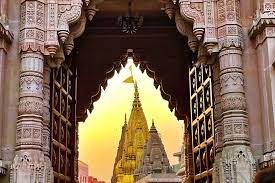
Corridor in Varanasi
Corridor in Varanasi: A Historical and Cultural Marvel
Varanasi, one of the oldest living cities in the world, is rich in spiritual significance, history, and culture. Beyond the ghats and temples, another architectural gem lies in the heart of the city — the corridor in Varanasi. This magnificent structure is not only an engineering marvel but also a testament to the city’s deep cultural and religious history.
In this blog, we will explore the corridor in Varanasi, its history, significance, and the impact it has on both locals and visitors alike. Whether you are a history enthusiast, architecture lover, or a curious traveler, the corridor in Varanasi will certainly capture your imagination.
What Is the Corridor in Varanasi?
The corridor in Varanasi refers to a vast and intricate system of pathways, temples, and architectural structures that connects various key religious sites in the city. The most prominent example of this corridor is the Kashi Vishwanath Corridor, a project that aims to rejuvenate the area surrounding the famous Kashi Vishwanath Temple.
This corridor is designed to make the sacred spaces more accessible and allow devotees and tourists to experience the spiritual ambiance in a more immersive way. The corridor in Varanasi includes numerous temples, narrow alleys, and courtyards, creating a seamless path that leads devotees and tourists through the heart of the city’s spiritual landscape.
The Significance of the Corridor in Varanasi
The corridor in Varanasi is not just an architectural feat but a symbolic bridge that connects the spiritual heart of the city with the lives of its people. Here are some of the reasons why this corridor is so important:
- Religious Importance: The corridor provides access to some of the holiest sites in Varanasi, including the revered Kashi Vishwanath Temple. It is a place where pilgrims from across India and the world come to perform religious rituals and seek blessings.
- Architectural Masterpiece: The intricate carvings, spacious pathways, and design elements of the corridor reflect the rich architectural heritage of Varanasi. Every stone in the corridor tells a story of the city’s history, religion, and culture.
- Cultural Relevance: Varanasi is a hub of cultural activities, and the corridor plays an important role in promoting the city’s artistic heritage. From classical music and dance performances to spiritual rituals, the corridor is a stage where the vibrant cultural traditions of Varanasi are showcased.
- Economic Impact: The development of the corridor has boosted tourism in Varanasi. The improved infrastructure has made it easier for visitors to access various attractions, thus promoting the local economy.
Historical Context of the Corridor in Varanasi
The concept of the corridor in Varanasi is deeply rooted in the city’s long history. Varanasi has always been a spiritual hub, with temples, ghats, and sacred spaces spread across its landscape. However, it wasn’t always easy for devotees to navigate through these sacred places.
Before the corridor’s development, many of these religious sites were either hard to access due to narrow lanes or lacked the facilities to accommodate large crowds of pilgrims and tourists. The need for a more structured and organized space became apparent, especially as Varanasi’s religious significance continued to draw millions of visitors.
The Kashi Vishwanath Corridor project, initiated in recent years, was designed to address these issues while also preserving the heritage and character of the old city. The development of the corridor has made the area more accessible, bringing together the city’s ancient charm and modern infrastructure.
Key Features of the Corridor in Varanasi
The corridor in Varanasi is a perfect blend of ancient architecture and modern construction. Here are some of its key features:
- Wide Pathways for Pilgrims
The new pathways allow pilgrims to walk freely, offering a peaceful environment for both spiritual practices and sightseeing. The old narrow lanes have been widened to ensure smoother movement and a better experience for visitors.
- Enhanced Temple Complex
The Kashi Vishwanath Temple, the focal point of the corridor, has been expanded with additional space for devotees to gather and perform rituals. The temple complex now includes new areas for religious and cultural events.
- Eco-Friendly Initiatives
Sustainability is a key aspect of the corridor in Varanasi. Efforts have been made to incorporate eco-friendly materials and features such as rainwater harvesting systems, solar panels, and green spaces, contributing to a cleaner and greener environment.
- Integration with the Local Community
The project has involved local artisans, craftsmen, and residents, ensuring that the corridor remains rooted in the cultural fabric of Varanasi. Local businesses have benefited from the increased foot traffic, while the community has been an essential part of the development process.
- Cultural and Spiritual Spaces
Along the corridor, there are dedicated spaces for cultural and spiritual events. These spaces help preserve and promote the ancient traditions of Varanasi, such as classical music, dance performances, and other local art forms.
- Architectural and Aesthetic Features
The corridor in Varanasi boasts intricate designs and architectural elements that reflect the ancient style of temple and palace construction. The stonework, carvings, and other ornamental features add to the overall spiritual experience.
The Benefits of the Corridor in Varanasi
The development of the corridor in Varanasi brings several benefits, both for the people of the city and for tourists who visit the sacred place. Here are some of the key advantages:
- Improved Accessibility: The corridor makes it easier for people, especially the elderly and disabled, to access the temples and ghats without difficulties.
- Better Tourist Experience: With improved facilities and easy-to-follow pathways, tourists can now enjoy a more seamless experience while exploring the holy sites of Varanasi.
- Preservation of Heritage: The project ensures the protection and conservation of the city’s ancient temples, making sure they remain intact for future generations.
- Promotion of Local Economy: By attracting more visitors, the corridor helps boost the local economy, providing opportunities for local businesses to thrive.
Famous Corridors in Varanasi
Apart from the Kashi Vishwanath Corridor, there are other corridors in Varanasi that are worth mentioning. Each of these corridors contributes to the spiritual and cultural richness of the city.
- Kedar Ghat Corridor: This corridor connects the Kedar Ghat to the nearby temples and shrines. It is a popular spot for pilgrims to take a ritual bath before entering the temples.
- Dashashwamedh Ghat Corridor: Connecting Dashashwamedh Ghat to the nearby temples, this corridor is bustling with activity, especially during the Ganga Aarti in the evenings.
- Assi Ghat Corridor: Assi Ghat is another prominent location in Varanasi, and its corridor provides a direct connection to several key temples and religious sites.
Conclusion
The corridor in Varanasi is more than just a physical space. It’s a bridge between the ancient spiritual practices of the city and the modern developments that aim to make it more accessible to people from all walks of life. Whether you’re visiting for religious reasons or simply to admire the beauty of Varanasi, walking through the corridor in Varanasi will undoubtedly be a memorable experience.
As Varanasi continues to grow and evolve, the development of the corridor will remain a significant part of its journey. The harmony between the old and new in the corridor not only enhances the city’s spiritual ambiance but also ensures that its rich cultural heritage will endure for future generations to appreciate.

Leave your comment